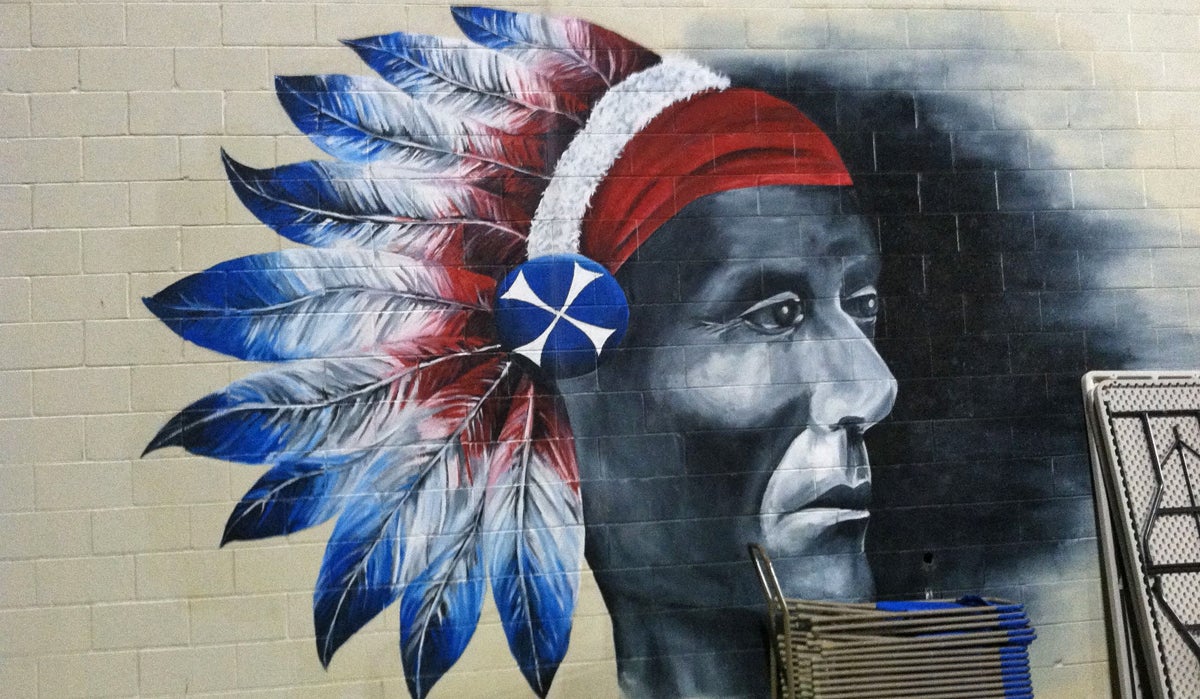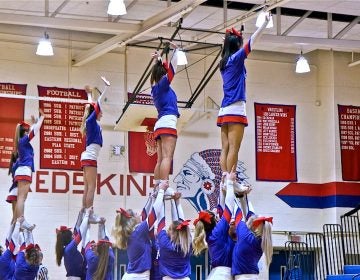Neshaminy teacher: ‘Redskins’ nickname ‘clearly is not’ a ‘term of honor’
The Pa. Human Relations Commission is weighing the fate of the school district’s controversial ‘Redskins’ nickname.

A mural of the Neshaminy High School mascot. (Eugene Sonn/WHYY)
Five years ago, a group of student editors at Neshaminy High School in Bucks County made national headlines as they fought to remove the name “Redskins” — the nickname for the school’s sports teams — from the school’s student newspaper.
On Tuesday, Tara Huber, the newspaper’s faculty advisor at the time, testified about the incident before a state commission weighing the school’s use of the term, which the commission argues is offensive to Native Americans.
Huber’s stance on the word hasn’t changed: “redskins” is a racial slur.
“Some people think that it is a term of honor and it clearly is not,” said Huber, an English teacher at Neshaminy High School, during the second day of a weeklong hearing called by the Pennsylvania Human Relations Commission.
Starting in 2013, student editors at The Playwickian pushed to not publish the word “redskins” anywhere in the monthly newspaper.
The decision was not well-received by school administrators.
“They felt that the editors did not have the authority to not publish the word,” said Huber, the newspaper’s advisor at the time.
While battling the school district over the use of the word, Huber was suspended for two days without pay.
Gillian McGoldrick, then the paper’s editor-in-chief, was suspended from the top post for a month.
Whiling testifying on Tuesday, McGoldrick said the editor’s effort to ban the word “redskins” from the school newspaper also drew criticism from fellow students and parents, some of whom posted their opinions on social media.
“I was 16 and my name was being thrown around by parents in the district — that I was some awful human being,” said McGoldrick.
“There were definitely times I really didn’t want to go to school,” said McGoldrick. “I was always anxious or on edge.”
In response to the student-led ban, the Neshaminy School Board passed a policy in 2014 that barred editors from removing “redskins” from editorials, but enabled them to keep the word out of news articles, including sports stories.
Huber said Tuesday the policy, which is still in place at the high school, violates students’ First Amendment rights to free speech.
“The fact that the editors are not allowed to edit certain things is what is unconstitutional,” she said. “This tells anyone reading it that they cannot construe something as being offensive or a slur.”
The district no longer has a physical mascot, or someone who dresses up as the “Neshaminy Redskin,” but the word and Native American imagery are still used to represent some of its athletic teams.
The logo for the high school’s basketball team is a profile of a Native American warrior wearing a feathered headdress; the football team’s helmets say “Skins” on them, and baseball players wear hats with a tomahawk on the front.
Students commonly wear clothing bearing the name “Redskins” at school, especially on game days.
The commission argues the Neshaminy mascot, which represents sports teams at the high school and one middle school, creates a “hostile educational environment” for all students.
The district, which enrolls more than 8,700 students across 10 schools, has argued the commission’s allegations are “unfounded.”
On Monday, an expert called by the district’s lawyers said there’s nothing inappropriate about the mascot, as long as it is used in context to describe Native American warriors who donned red face paint before battle.
“It should be treated as a living tradition,” said Andre Billeaudeaux, executive director of the Native American Guardians Association. “It should be treated objectively.”
The commission sued the Neshaminy School District in 2015. It filed the lawsuit after a Neshaminy parent with Native American lineage filed — and later voluntarily withdrew — a complaint with the commission over the district’s use of the mascot.
The commission found the argument laid out the complaint, which also focused on the educational impact on students, had probable cause.
The hearing is expected to continue through the week.
Disclosure: A Neshaminy High School graduate who works at WHYY was deposed as part of the commission’s case.
WHYY is your source for fact-based, in-depth journalism and information. As a nonprofit organization, we rely on financial support from readers like you. Please give today.



